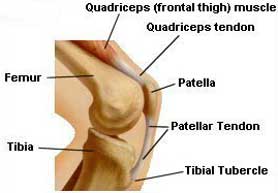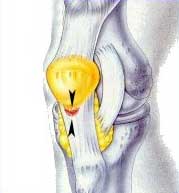|
Patellar Tendinitis is an
extremely common malady that can plague almost anyone, from athletes
to laborers. It originally took on the nickname of "Jumper's
Knee" because it frequently appeared in athletes who performed
a lot of jumping and landing activity. Such exertions subject
the knee to high shock-impact forces, which are one of the apparent
causes of patellar tendinitis. The patellar tendon is a broad,
thick, ligament-like structure that connects the lower portion
of the patella (kneecap) to the prominent bump on the front of
the upper tibia ("shin-bone") known as the tibial tubercle
(see FIGURE 1). The patellar tendon
is what doctors tap with a rubber hammer when they test your knee
reflexes.
 |
| FIGURE
1 - Basic knee anatomy, showing the patella (kneecap)
in the front of the joint. The patella is connected to the
quadriceps (frontal thigh) muscle above it by way of the quadriceps
tendon. It is connected to the tibia below by the patellar
tendon. The latter tendon is much more commonly afflicted
with tendinitis than the former. |
For unknown reasons, the insertion (attachment) of the middle
fibers of the patellar tendon to the lower border of the patella
is particularly vulnerable to mechanical irritation, inflammation
and ultimately tendon fiber degeneration and breakdown (see
FIGURE 2). The patellar attachment sites of the medial
(inner side) tendon fibers and lateral (outer side) tendon fibers
are much less commonly affected than that of the middle fibers.
Under the microscope, the disease process associated with jumper's
knee is characterized by cellular inflammation and degenerative
breakdown of tendon fibers directly where the tendon attaches
to the patella, and in more advanced cases, within the upper
third of the tendon itself.
 |
| FIGURE
2 - Schematic anatomy diagram demonstrating the most
common site of the inflammation and microscopic tissue breakdown
that characterizes patellar tendinitis. |
Patellar tendinitis can be thought of as the "tennis elbow
of the knee". While surgery is only infrequently required
for effective treatment, jumper's knee can be quite annoying and
difficult to cure at times. It can appear in a variety of circumstances,
many of which do not involve running or jumping at all! One common
cause of patellar tendinitis is a direct contusion or impact blow,
such as may occur when you fall down onto the frontal aspect of
your knee, or if you strike the front of your knee on an unseen
object while walking. Another common cause is altered gait and
thigh muscle mechanics, as may occur during limping or partial
weight-bearing while using crutches following knee injury or surgery.
In my experience I have learned that over-use, abnormal
use or occasionally even under-use of the knee can
lead to this common knee condition!
|



